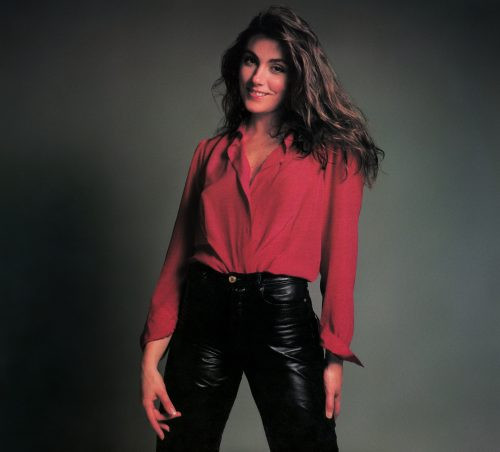Laura Branigan’s “Gloria” is an iconic anthem of the 1980s, instantly recognizable by its synth-driven energy and Branigan’s powerful vocals. For many, it’s simply a defining song of the era. However, the story behind this hit is more layered than it might seem at first listen. “Gloria” wasn’t originally a song by Laura Branigan; it was a reimagining of an Italian ballad that transformed into an international sensation. This article delves into the fascinating journey of “Gloria,” exploring its origins, Branigan’s masterful cover, and the lasting impact of this unforgettable song.
 Laura Branigan performing Gloria, showcasing her powerful vocals and signature 80s style, in a promotional image for her hit cover song.
Laura Branigan performing Gloria, showcasing her powerful vocals and signature 80s style, in a promotional image for her hit cover song.
The Italian Roots of “Gloria”: Umberto Tozzi’s Original Ballad
Before Laura Branigan brought “Gloria” to the American charts and global airwaves in 1982, the song existed in a different form and language. Umberto Tozzi, a prominent Italian singer-songwriter, first released “Gloria” in 1979. Tozzi, who had already established himself as a successful musician in Italy and Europe, crafted “Gloria” as a fairly traditional Italian pop love song. Sung in Italian and addressed to an imagined woman named Gloria, the original version showcased Tozzi’s emotive vocals and a gentler, more romantic musical arrangement.
While successful in Europe, Tozzi’s “Gloria” remained largely unknown to English-speaking audiences. The narrative of the song, a heartfelt expression of love and longing, was potent in its original Italian form, but it needed a cultural and linguistic bridge to reach a wider global audience. This bridge came in the form of translation and reimagination, setting the stage for Laura Branigan’s transformative cover.
From Italian to English: The Evolution of “Gloria”
The journey of “Gloria” from Italian ballad to English-language hit involved several steps and interpretations. Jonathan King, a British songwriter and producer, played a crucial role in bringing “Gloria” to the English-speaking world. King translated the Italian lyrics into English and released his own version shortly after Tozzi’s original. This English rendition marked the first significant step in adapting “Gloria” for a broader audience, although it didn’t achieve widespread popularity.
Interestingly, even Umberto Tozzi himself explored the potential of the English lyrics, releasing his own English version based on King’s translation. These early English versions, along with covers in other languages like Czech and Estonian, demonstrated the song’s inherent appeal and its potential to resonate across different cultures. However, it was Laura Branigan’s interpretation that would ultimately unlock the song’s full potential and transform it into a global phenomenon.
Laura Branigan’s “Gloria”: A Synth-Pop Anthem is Born
Laura Branigan’s path to “Gloria” involved a blend of ambition, talent, and a touch of serendipity. Having honed her vocal skills from high school productions to backing vocals for Leonard Cohen, Branigan signed with Atlantic Records in 1979. Initially, her solo career didn’t immediately take off. However, Atlantic Records and producer Jack White saw the potential in “Gloria.”
Branigan, White, and arranger Greg Mathieson initially attempted to adapt “Gloria” as a love song titled “Mario.” Dissatisfied with this direction, they collaborated with lyricist Trevor Veich (with likely input from Branigan herself) to reimagine the song entirely. The lyrics shifted focus, portraying Gloria as a woman “running too fast for her own steps,” imbuing the song with a sense of urgency and dramatic tension. This lyrical reinterpretation, combined with a new, energetic synth-pop production, proved to be the magic formula.
Branigan’s powerful and emotive vocal delivery, coupled with the song’s infectious melody and danceable rhythm, catapulted “Gloria” to the top of the charts in 1982. The song’s success was also fueled by the promotional efforts of Atlantic Records, as recounted by an industry insider who witnessed the song’s rise firsthand. “Gloria” earned Branigan a Grammy nomination and became her signature song, defining her career and solidifying her place in 80s music history.
“Gloria”‘s Lasting Legacy and Continued Popularity
Laura Branigan’s “Gloria” transcended its initial chart success to become a timeless classic. Its enduring appeal is evident in the numerous covers and appearances in popular culture that continue to this day. From sports arenas to movie soundtracks, “Gloria” remains a go-to anthem for celebration and empowerment.
Branigan herself enjoyed further synth-pop hits throughout the 1980s, including “Self Control” and “Solitaire,” cementing her status as a leading voice of the era. Although she stepped back from the industry in the mid-90s and tragically passed away in 2004, her musical legacy, particularly through “Gloria,” continues to inspire and entertain generations.
In conclusion, the story of “Gloria” is a testament to the transformative power of cover songs. From its humble beginnings as an Italian ballad to its explosive reinvention as a synth-pop anthem by Laura Branigan, “Gloria” exemplifies how a song can cross linguistic and cultural boundaries to achieve global recognition and lasting impact. Branigan’s “Gloria” is not just a cover; it’s a definitive version that has eclipsed its origins, becoming a beloved and enduring song in its own right.

